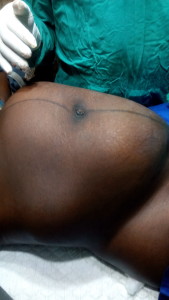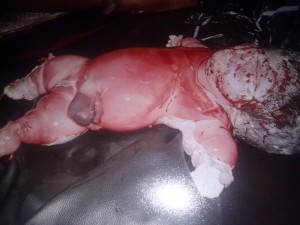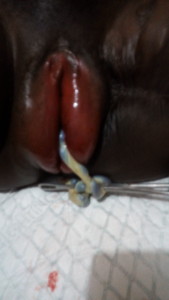
Intra- uterine death from Prolonged Obstructed Labour an early Ceaseran section could have averted this.

Big fetus with co-existing uterine myoma (Fibroid) in a primigravida with prolong obstructed labor been prepared for caesarean section.

Severe neonatal Asphyxia baby on oxygen support from Prolonged Obstructed Labor
WHAT IS PROLONGED OBSTRUCTED LABOR?
Prolonged obstructed labor, also known as failure to progress, occurs when labor last for approximately 20 hours or more if you are a first –time mother, and14 hours or more if you have previously given birth. A prolonged latent phase happens during the first stage of labor. It can be exhausting and emotionally draining, but rarely leads to complications.
However, prolonged labor during the active phase of giving birth can be cause for concern. If you experience failure to progress, your health care provider will begin running tests to determine the cause.

Mascerated still birth resulting from Prolonged Obstructed Labour with associated Exomphalos.
WHAT CAUSES PROLONGED OBSTRUCTED LABOR?

Congenital malform baby which was deliver through Caesarean Section after mother as been in 3 days in Labor

Appearance of the vulva in Prolonged Obstructed Labor with a fresh still birth.

Hydrocephalus baby delivered via caesarean section after 2 days in Labor.
There are a number of possible causes of prolonged labor.
- During the latent phase, slow effacement of the cervix can cause labor time to increase. During the active phase, if the baby is too large and the birth canal is too small, or the woman’s pelvis is too small, delivery can take longer or fail to progress.
- Carrying multiple fetus may also lead to prolonged labor, as might on weak uterine contractions, or an incorrect position of the baby.
- Research has also linked prolonged labor or failure to progress to psychological factors, such as worry, stress, or fear.
- ‘Some other causes of obstructed labor may be mal presentation or mal position of the fetus (shoulder, brow or occipito-posterior positions). In rare cases, locked twins or pelvic tumors can cause obstruction.
MATERNAL FEATURES IN ANTENATAL CARE THAT CAN BE A POINTER TO PROLONG OBSTRUCTED LABOR
- Under aged mothers.
- Pregnant women below five (5) feet in height.
- Women with congenital malformation of the hip bone.
- Pregnant women with Haemoglobinopathy.
- Women with congenital malformation of backbone. eg scoliosis, lurdosis .
- Severe depression in women with unclaimed pregnancy or family dispute.
- Severe polyhydranimous.
- Women with severe adhensions from previous surgeries.
- Some women with chronic diseases which could be infective like tuberculosis or inflammatory joint disorders.
WHAT ARE THE COMPLICATIONS OF PROLONGED OBSTRUCTED LABOR?
Neglected obstructed labor (OL) is a major cause of both maternal and newborn morbidity and mortality.
”Common maternal complications of obstructed labour may include the following:
- Paralytic ileus.
- Post partum hemorrhage (PPH).
- Fistula formation.
- Skeletal & neurological complications.
- Short time paralysis of the lower limbs.
- Severe depression.
”Common fetal complications of obstructed labor may include the following:
- Neonatal sepsis.
- Intrauterine fetal death.
- Fresh or macerated still birth.
WHAT ARE THE CARDINAL SIGNS OF OBSTRUCTED LABOR?
Early referral can save the life of the woman and the baby in case of obstructed labor
The clinical feature of obstructed labor includes:
- Mother stay in labor for more than 12 hours;
- Exhausted and unable to support herself.
- Deranged vital signs.
- ”Bandl’s ring formation in the abdomen.
- Bladder full above the symphysis pubis, big caput and big moulding, may be edematous vaginal opening”.
HOW IS PROLONGED LABOR DIAGNOSED?
In Africa health set up just like most developing world, partograph is often used to track labor progression and diagnose problems. This combined with physical examination may identify obstructed labor and avert the complications that are usually associated with it.
DOES PROLONGED OBSTRUCTED LABOR HAVE EFFECTS ON MY BABY?
Obstructed labor affects between two and five percent of deliveries. According to statistics in 2015 about 6.5 million cases of obstructed labor or uterine rupture occurred. In our center Adebayo Living-Tower Hospital prolong obstructed labor accounted for about 2/3 of our received labor emergencies requiring caesarean section or assisted deliveries referred to our center and accounted for about 95% of neonatal death.
WHAT IS THE MEDICAL TREATMENT FOR PROLONGED OBSTRUCTED LABOR?
The medical treatment for obstructed labor may require emergency caesarean section or vacuum extraction.

Recent Comments